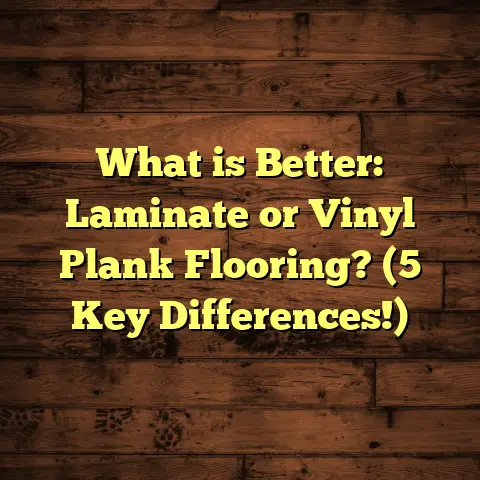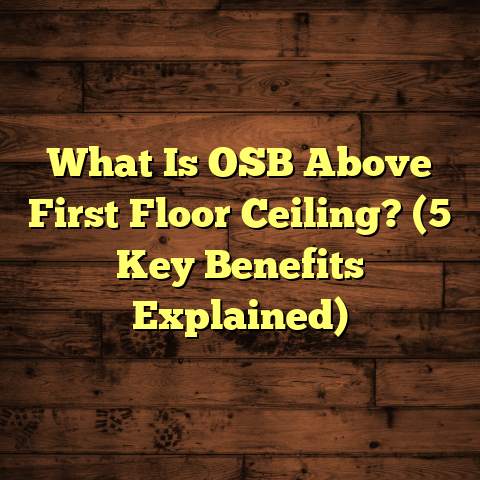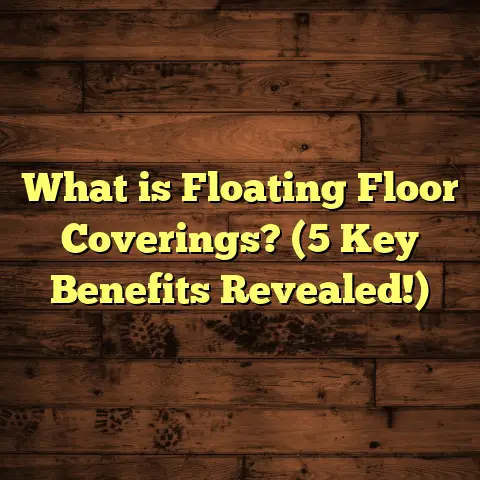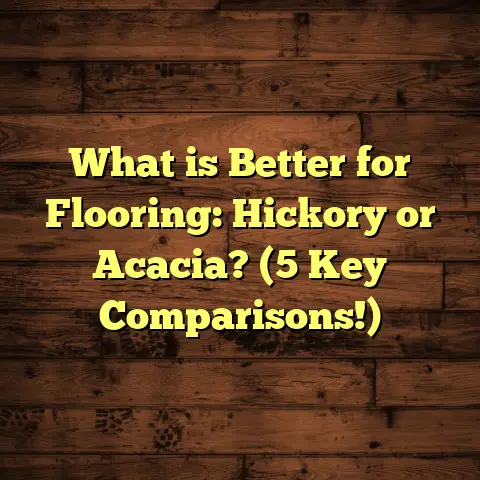What is Strand Bamboo Flooring? (5 Facts You Didn’t Know!)
I’ve always been into projects around the house — especially those where you can see and feel a real transformation, like flooring. When I started exploring different flooring options years ago, I was fascinated by strand bamboo flooring. It wasn’t just a pretty material; it felt like something different from all the hardwoods and laminates I’d worked with before. Over time, I learned a lot about what makes strand bamboo flooring special, and I want to share those insights with you. There are some facts about it that might surprise you — things I didn’t realize until I dug deeper myself.
What is Strand Bamboo Flooring?
Let’s start with the basics: What is strand bamboo flooring? You may have heard of bamboo floors before — they’ve grown in popularity because bamboo is a fast-growing grass and considered more sustainable than many hardwoods. But strand bamboo flooring is a bit different from your regular bamboo planks.
Strand bamboo flooring is made by shredding whole bamboo stalks into long fibers or strands. These strands are then mixed with adhesives and pressed under intense heat and pressure into very dense, solid planks. The process creates a dense, strong core that’s far more durable than traditional bamboo flooring made by slicing bamboo stalks into strips.
The surface is then sanded, smoothed out, and coated with a protective finish that gives it shine and resistance to wear.
What differentiates strand bamboo from other bamboo floors?
Traditional bamboo flooring is usually made using horizontal or vertical planks. Horizontal bamboo has strips glued side by side creating visible nodes or joints, while vertical bamboo has strips aligned on their ends to produce a straight grain. Both methods involve slicing the stalks directly, which makes the floor less dense and softer than strand bamboo.
Strand bamboo’s tangled fiber construction means it’s denser, harder, and more resistant to denting and scratching. Plus, its grain pattern is more variegated and natural-looking — closer to hardwood than typical bamboo floors.
The manufacturing process in detail
Here’s how it works step-by-step:
- Harvesting: Mature bamboo stalks (usually 5-6 years old) are cut.
- Stranding: Instead of slicing, the stalks are shredded into thin strands or fibers.
- Drying: The strands are dried to the right moisture level.
- Adhesive coating: Strands are mixed with strong adhesives — commonly urea-formaldehyde or phenol-formaldehyde resins (modern low-VOC options are now available).
- Pressing: The adhesive-coated strands are compressed under extremely high heat and pressure (often 1,000 psi or more) to form thick, flat boards.
- Cooling & Curing: The planks cool and harden.
- Finishing: The surface is sanded smooth and finished with multiple layers of polyurethane or aluminum oxide coatings to protect against scratches and moisture.
Because of this process, strand bamboo flooring resembles an engineered wood product but is made entirely from one material — bamboo fibers. It’s sometimes called “woven bamboo” or “strand-woven bamboo” due to how the fibers intertwine.
1. Strand Bamboo Flooring is One of the Hardest Natural Flooring Materials Available
If durability matters to you — as it should — here’s where strand bamboo really shines. The Janka hardness test is the industry standard for measuring how resistant flooring material is to denting and wear.
Strand bamboo scores between 3,000 and 3,700 pounds-force (lbf) on the Janka scale.
What does that mean? Let’s compare:
- Red oak: 1,290 lbf
- Hard maple: 1,450 lbf
- Traditional horizontal bamboo: ~1,380 lbf
- Strand bamboo: 3,000 – 3,700 lbf
Strand bamboo can be almost three times harder than oak! That’s huge when you think about everyday impacts — from dropping objects to pet claws or heavy furniture.
Real-world durability
I’ve installed strand bamboo floors in homes with kids and active pets, and the difference shows over time. For example:
- A family in Seattle had strand bamboo installed in their kitchen and living room.
- After two years of heavy use (including toddlers playing and a large dog running around), their floor had minimal signs of wear.
- Meanwhile, their friends’ hardwood floors showed scratches and dents after just one year.
This level of hardness means strand bamboo is ideal for areas where durability is crucial: kitchens, entryways, even commercial spaces with moderate foot traffic.
What about scratch resistance?
The finish applied on top of strand bamboo plays a big role here. Most manufacturers use aluminum oxide coatings that provide extra scratch resistance. Some brands even offer extra-thick finishes for commercial applications.
Here’s a quick note: No floor is completely scratch-proof if you’re rough with it — but strand bamboo gives you a much higher margin for error compared to softer woods.
2. Bamboo’s Fast Growth Makes Strand Bamboo Environmentally Friendly — But It’s Complex
Bamboo’s reputation as an eco-friendly material comes from how quickly it grows compared to hardwood trees. Some species can grow up to three feet per day under ideal conditions. This rapid growth lets farmers harvest mature stalks every 3-5 years — much faster than hardwoods that can take 20+ years to mature.
Because strand bamboo uses shredded fibers rather than sliced strips, it utilizes the entire stalk more efficiently — reducing waste during production.
Sustainability benefits:
- Rapid renewability: Bamboo regrows from the root system without needing to be replanted.
- Reduced deforestation pressure: Using bamboo helps ease demand on slow-growing hardwood forests.
- Lower carbon footprint: Bamboo absorbs carbon dioxide rapidly during growth.
- Biodegradable material: Bamboo fibers break down naturally at end of life.
But there are some complexities
While the raw material is sustainable, manufacturing strand bamboo involves adhesives and finishes that impact the overall environmental footprint.
- Some adhesives used emit formaldehyde — though many brands now use low-VOC or no-added-formaldehyde resins.
- Manufacturing plants may be located far from the consumer market (most production happens in China), so transportation adds carbon emissions.
- Not all bamboo farms follow responsible harvesting practices — look for FSC certification or equivalent to ensure ethical sourcing.
My take on eco-friendliness
In my projects, I always recommend clients:
- Ask about certifications like FSC or FloorScore (indoor air quality).
- Choose products with low-VOC finishes.
- Consider lifecycle impacts — including installation waste and disposal options.
If you want a green floor that performs well and looks great, strand bamboo fits nicely — just be sure to check the details from your supplier.
3. Moisture Resistance: Why Strand Bamboo Holds Up Better Than Hardwood (But Isn’t Waterproof)
If you’ve ever dealt with warped hardwood floors after spills or humidity changes, you know how frustrating it can be.
Strand bamboo’s construction makes it more dimensionally stable than many hardwoods:
- The compressed fiber core means less expansion and contraction with moisture fluctuations.
- This stability reduces risks of cupping, warping, or gaps forming.
- It performs well in moderate humidity environments like kitchens or basements (with proper subfloor prep).
But it’s not waterproof
I’ve had clients ask if they can install strand bamboo in bathrooms or laundry rooms. The answer: No floor made from wood or plant fibers is truly waterproof.
Standing water left on strand bamboo will eventually seep into seams or damage the finish. Over time this leads to swelling or mold growth beneath the surface.
Best practices for moisture resistance:
- Use moisture barriers beneath strand bamboo when installing over concrete slabs.
- Maintain indoor humidity levels between 30-50%.
- Clean up spills immediately.
- Avoid installing in rooms prone to flooding or standing water without additional protection.
- Use area rugs in high-risk spots.
In one project I did for a coastal home with high humidity, we installed strand bamboo with a vapor barrier underlayment plus a high-quality finish sealed along all edges. That combo helped keep moisture damage at bay even during humid summers.
4. Installation Flexibility Makes Strand Bamboo Ideal for Many Situations
One of the best things I’ve learned about strand bamboo flooring is how versatile it is when it comes to installation methods.
You can find strand bamboo products designed for:
- Nail-down installation: Requires wooden subfloor; provides solid feel underfoot.
- Glue-down installation: Great for concrete slabs; creates permanent bond.
- Floating floor installation: Click-lock planks snap together over underlayment; easier DIY option that allows some movement.
This flexibility means strand bamboo can go in places where hardwood might not be suitable or would require expensive prep work.
Floating floors: A DIY favorite
I’ve installed floating strand bamboo floors myself in rental units where tenants wanted an upgrade but budget was tight.
No glue or nails meant faster installation with less mess. Floating also lets you install over old vinyl or tile without removing them — saving time and disposal costs.
Subfloor prep tips
To get a perfect installation regardless of method:
- Make sure subfloor is clean, dry, and level within 3/16 inch per 10 feet.
- Use moisture barriers on concrete slabs.
- Acclimate flooring planks indoors 3–5 days before installation to balance moisture content with room conditions.
Failing to prep properly can cause gaps or buckling later on.
5. Design Variety: More Styles and Finishes Than You Might Expect
When most people think of bamboo flooring, they picture light yellowish planks with a uniform grain.
Strand bamboo breaks that mold in big ways:
Grain & texture
Because the fibers are tangled during manufacturing, strand bamboo showcases a more varied grain pattern with swirls and knots like natural wood.
This adds richness and interest that can complement rustic styles as easily as contemporary ones.
Color options
Strand bamboo takes stains well thanks to its fiber composition. Here are some popular finishes I’ve seen clients choose:
| Finish Style | Description | Best For |
|---|---|---|
| Natural | Light honey tones with golden hues | Casual spaces; Scandinavian style |
| Carbonized | Rich amber/brown shades created by heating | Warm interiors; traditional look |
| Espresso/Dark | Deep brown/black tones | Modern spaces; dramatic effect |
| Gray Wash | Cool grayish hues | Industrial or minimalist décor |
| Exotic Colors | Custom colors like whitewash or even blue | Unique statement floors |
Texture & sheen levels
You can also select from smooth satin finishes for subtle shine or hand-scraped textures for rustic charm. Matte finishes hide scratches better but reflect less light; glossy finishes add drama but show imperfections easier.
Personal Story: Installing Strand Bamboo Flooring in My Own Home
I want to share an experience that really changed my view on this product.
A few years ago, I decided to replace my tired old oak floors in my living room with something harder and more eco-friendly. After research and sampling many materials, I chose strand bamboo in a medium carbonized finish.
The installation was straightforward since I opted for floating click-lock planks over my existing plywood subfloor.
Within weeks:
- I noticed how little noise footsteps made compared to my old floors.
- My cat’s claws didn’t leave marks like before.
- The rich grain pattern gave my space warmth without feeling dated.
After two years of daily use—kids running around, occasional spills—the floor has held up beautifully. No scratches beyond minor scuffs that easily buff out during annual maintenance.
This personal experience plus client feedback confirmed for me that strand bamboo offers a winning combination of beauty, durability, and eco-consciousness.
Common Questions About Strand Bamboo Flooring
I get asked quite a few common questions when folks consider this flooring option:
How long does strand bamboo flooring last?
With proper care, strand bamboo floors can last 25+ years. Its hardness reduces wear-and-tear significantly compared to softer woods.
Can I refinish strand bamboo floors?
Yes! Most strand bamboo floors can be sanded and refinished multiple times depending on plank thickness—just like hardwoods. This extends their lifespan even further.
Is it pet-friendly?
Definitely. The hardness resists scratches from claws better than most wood floors. Just keep nails trimmed to avoid damage over time.
Does it off-gas harmful chemicals?
Modern brands use low-VOC adhesives and finishes certified by FloorScore or similar programs. If indoor air quality matters to you, check certifications before buying.
How does price compare?
Strand bamboo typically costs between $5 – $8 per square foot installed—slightly higher than traditional bamboo but competitive with mid-range hardwoods.
Case Study: Commercial Use of Strand Bamboo Flooring
I once consulted on a boutique retail store project where durability was key due to heavy foot traffic from customers daily.
The client chose strand bamboo flooring because:
- It offered superior hardness to hardwood alternatives.
- It provided a unique aesthetic that matched their brand image.
- Installation could be done quickly over concrete slab using glue-down method.
After six months:
- The floor showed minimal wear despite hundreds of visitors daily.
- Maintenance was straightforward—regular sweeping plus occasional damp mopping.
- The client reported positive customer feedback on the store’s warm atmosphere linked to natural wood tones.
This case confirmed for me that strand bamboo isn’t just for homes—it works well in commercial spaces needing both style and strength.
Comparing Strand Bamboo Flooring With Other Popular Flooring Types
To help you visualize where strand bamboo fits in your options list, let’s look at how it compares across several factors:
| Feature | Strand Bamboo | Hardwood | Laminate | Vinyl Plank | Tile |
|---|---|---|---|---|---|
| Hardness | Very high (3,000+ Janka) | Moderate (1,200 – 1,500) | Moderate (varies) | N/A (synthetic) | Very high (ceramic/porcelain) |
| Durability | Excellent | Good | Good | Very good | Excellent |
| Moisture Resistance | Moderate | Low | Low | High | High |
| Eco-Friendliness | High | Moderate | Low-Medium | Low | Medium |
| Installation Methods | Nail/Glue/Floating | Nail/Glue | Floating | Floating | Mortar/Bonded |
| Maintenance | Moderate | Moderate | Low | Low | Low |
| Style Variety | High | Very high | Moderate | Very high | Very high |
| Cost per Sq Ft | $5-$8 | $4-$10 | $2-$5 | $3-$7 | $5-$15 |
Maintenance Tips for Strand Bamboo Floors That Last
From my personal experience and client feedback, here are some practical tips to keep your strand bamboo floor looking its best:
- Sweep/dust mop regularly to remove grit that can scratch surfaces.
- Damp mop occasionally using manufacturer-recommended cleaners—avoid excess water.
- Use furniture pads under heavy pieces to prevent dents.
- Trim pets’ nails often.
- Avoid harsh chemicals or abrasive scrubbers.
- Refinish every 7–10 years depending on wear patterns.
- Protect entryways with mats to reduce dirt tracked inside.
Regular care pays off by maintaining appearance and prolonging lifespan significantly.
Final Thoughts on Strand Bamboo Flooring
Choosing flooring means balancing looks, durability, budget, and environmental impact—no small task!
From what I’ve seen firsthand installing strand bamboo in homes and businesses, it offers a unique combination of toughness, beauty, and sustainability hard to match elsewhere in natural materials.
It outperforms traditional hardwoods in hardness, stands up better against moisture fluctuations, and gives you styling flexibility through stains and textures that fit any design taste.
If you want a natural floor that works hard without compromising style, strand bamboo deserves serious consideration!
What about you? Have you experienced any challenges or wins using this flooring? Happy to share advice or answer questions anytime!





